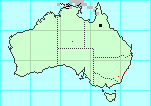
Common Name:
Delete this section if there is no common name.
Identification:
Length:
Coloring:
Note any distinguishing features.
The tegmina are of a violet-brown, with a short longitudinal white line
at the tip; the basal half of the wings is yellowish white, with the
apical half dusky; the costal area is dark yellowish brown, with the
base yellow; the antennæ are pale brown; the head is blackish with
three distinct stemmata placed triangularly in front; the mesothorax
is scattered with sharp tubercles, and is yellowish brown; the abdomen
is rather darker, with the tip rather black; the legs are rather short,
dentated, especially the thighs.
(from
Gray, 1933)
-
Body length: male 100-114 mm, female 143-155 mm.
-
Coloration: Brownish green, robust species, particularly in female.
-
Head: Round, as long as wide. Antennae reaching ½ length of foretibiae
in male, shorter than fore femora in female.
-
Thorax: Very spiny. Prothorax almost as long as head, female spinier
than male. Mesonotum approximately 4 × length of pronotum, with
numerous bold brown spines. Metanotum smooth, shorter than mesonotum.
-
Abdomen: Long and fairly broad in female, much more slender in male. Apex
of anal segment incised in center. Cerci leaf-like, much longer than anal
segment in female, shorter in male. Female operculum long, keel-shaped,
reaching end of anal segment. Subgenital plate broad in male, not
reaching end of 9th segment.
-
Wings: Forewings long, oval in female, more curved in male, which are
more mottled, along with pre-anal part of hind wings. Hind wings longer
in male than female, but a variable feature.
-
Legs: All legs serrate. Hind legs of modest length, reaching approximately
length of 7th abdominal segment in female, 9th segment in male.
(From Brock and Lowe,
1998.)
 Note parental placement of eggs.
Note appearance of eggs.
Note any common variations.
Note parental placement of eggs.
Note appearance of eggs.
Note any common variations.
Egg: Capsule round, glossy black. The micropylar plate is long, grey
and surrounded by a grey band. Capitulum large, pale yellow. Capsule
length 3.5 mm, width 2.5 mm, height 3 mm.
Habitat:
Note if the species arborial or terrestrial.
Canopy, mid, under, etc.
Note typical vegetation, e.g.
tropical rainforest, temperate rainforest,
grasslands,
alpine, etc.
Foodplants: Eucalyptus species.
Similar Species:
Rearing Notes:
Note if this species has ever been reared.
Note any suggestions for successful rearing.
For a stick insect with body length 155mm, to keep 2 adult females,
you need a cage at least 700mm high, 350mm deep and 350mm wide.
 Range:
Range:
N coastal, N Gulf, QLD, NT
Status:
It is not known if this species is endangered,
as there is insufficient sighting history.
References:
-
Balderson, J., Rentz,
D.C.F. and Roach, A.M.E. (1998).
in
Houston, W.K.K. & Wells, A. (1998) (eds)
Zoological Catalogue of Australia.
Vol. 23.
Archaeognatha, Zygentoma, Blattodea, Isoptera, Mantodea, Dermaptera,
Phasmatodea, Embioptera, Zoraptera.
Melbourne: CSIRO Publishing, Australia (ISBN 0643 06035 9).
pp. 347 - 376.
-
Brock, P.D. and Lowe, L.M. (1998).
A Study of Stick-insects (Phasmida) from Kakadu National Park,
Northern Territory, Australia.
J. Orthoptera Research, 7: 71-76
-
Gray, G.R. (1833).
The Entomology of Australia in a Series of Monographs. Part 1.
The monograph of the genus Phasma.
London: Longman & Co. 28 pp. 8 pls
-
Gray, G.R. (1835).
‘Synopsis of the Species of Insects Belonging to
the Family of Phasmidae.’ 48pp.
(Longman, Rees, Orme, Brown, Green and Longman: London.)
-
Rainbow, W.J. (1897).
Catalogue of the described Phasmidae of Australia.
Records of the Australian Museum, 3(2), 37-44.
[Note that he made a mistake re Extatosoma popa and E. tiaratum
according to
Gurney, A.B. (1947).
Notes on some remarkable Australasian walkingsticks, including a
synopsis of the Genus Extatosoma (Orthoptera: Phasmatidae).
Annals of the Entomological Society of America. 40(3): 373-396.
.]
-
Tepper, J.G.O. (1902).
List of the Described Genera and Species of the Australian and Polynesian
Phasmidæ (Spectre-Insects).
Transactions of the Royal Society of South Australia, 26: 278-287.
-
Vickery, V.R. (1983).
Catalogue of Australian stick insects (Phasmida,
Phasmatodea, Phasmatoptera, or Cheleutoptera). CSIRO
Australian Division of Entomology Technical Paper, No. 20, 15 pp.
- Search Google for
Anchiale spinicollis,
or search Google Scholar for
Anchiale spinicollis.
Synonyms:
Copyright © 2000-2003
Peter Miller
This page was last changed 20-Sep-2006.
|

|

|
 Note parental placement of eggs.
Note appearance of eggs.
Note any common variations.
Note parental placement of eggs.
Note appearance of eggs.
Note any common variations.

 Note parental placement of eggs.
Note appearance of eggs.
Note any common variations.
Note parental placement of eggs.
Note appearance of eggs.
Note any common variations.
 Range:
Range: 
